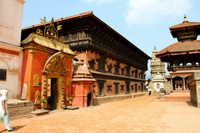

Most of Nepal’s temples are still standingThe last few weeks have been burdened by the dour and devastating news from Nepal and the 7.8 earthquake that hit it on April 25th. I’ve written about it and spent countless hours helping, searching and trying to do what I can to help. Now, nearly two weeks later the dust has settled. Aid is getting to the remoter villages. Utilities are being restored. Damaged buildings are being taken down safely. There’s finally good news filtering in. Last week I began a project with my good friend Amir to locate all the major temples in Kathmandu, Bhaktapur and Patan to see what really was destroyed. I’ve written up a list of destroyed temples in Nepal here. It’s a sad read for me as I know all of those temples. However, at the completion of the survey we came to an overwhelming conclusion.
Indeed, many don’t even look to have a scratch on them other than the sands of time. Let’s take a look at the behemoths, architecturally great, visually stunning and culturally unforgettable great buildings still standing in Nepal. Temples in Kathmandu Durbar SquareKathmandu’s durbar square took a beating. My favourite sitting spot at dawn, Maju Dega, and sunset, Trailokya Mohan are gone. As is the temple that gave Kathmandu its name Kasthamandap. But look at the temples that remain!  Nepal still has more heritage sites concentrated in one area than anywhere else on earth.  Nepal’s prime minister has promised that all of Nepal’s fallen temples will be rebuilt.  All the Kumari houses in Kathmandu, Patan and Bhaktapur survived as did the Kumaris.  Kathmandu Durbar Square took a beating, but there is still so much there to see.  List of surviving temples in Kathmandu Durbar SquareKumari House, Bimaheshwor Temple, Kabindradpur Sattal, House of the Priest, Kal Bhairab, Kabindra, Mahhendreshwar Temple, Taleju Temple, Vishnu & Indraha Temples and Jagannath Temple. Temples still standing in PatanOf all the durbar squares in Kathmandu Valley Patan took some the heaviest losses. It’s a smaller area than the other squares but this city makes up for it in artisitc value. Most of this still stands today.  Some of Kathmandu Valley’s oldest and artistic buildings are still found in Patan.  Much of South Patan and North Patans temples were not destroyed by the earthquake.  Patan is known as the city of artists for a reason. Many of whom will be involved in the reconstruction of lost temples.  Temples survived the earthquake in PatanThe Golden Temple, North Stupa, Kumari House, Krishna Mandir, Shikarra Temple, Chyasin Dewal, Bishwakaram Temple, I Baha Bahi Monastery, Machchhendranath Temple and Uku Bahal all survived. Temples still standing in BhaktapurNearly all of Bhakrapurs great temples are still standing. Far too many to list here. But here are some of the greats.  Dattatreya square in Bhaktapur suffered only one small casualty in terms of collapsed temples. The main Dattatreya temple and others still stand.  Much of Taumadhi Tol in Bhaktapur survived. Only the small Betal temple next to Bhairabnath temple collapsed.  Bhaktapur Durbar square lost the stone Vatsala Durga Temple. A beautiful temple that can be reconstructed again. The majority of temples in Bhaktapur survived with only mild damage: Swayambhunath, Boudhanath & Pashupatinath are all open to visitors tooWhile Swayambhunath lost one white brick chedi known as Anantapur it can be reconstructed. Moreover the rest of the iconic “monkey temple” still stands. (update: further investigation has revealed cracks around the stupa. While the site is open to visitors it’s envisioned the structure will need extensive repairs.) 
Likewise the giant stupa at Boudhanath only has a small crack at its base and some superficial damage. 
Finally Pashupatinath is virtually unscathed.  The one temple that survived that we can learn fromChyasilin Mandap is not a temple no matter what the guidebooks say. It is a pavilion built in the 17th century under the Malla Kingdom. It’s main purpose was to deflect a powerful “force” coming from a nearby Shiva temple. It was later used as a meeting place and a tax office. During the 1934 earthquake Chyasilin Mandap was completely destroyed. In the late 1980s the then Chancellor of Germany Helmut Cole was due for a state visit. Protocol dictated a gift should be given to Nepal. Funded by Germany, architects Götz Hagmüller and Niels Gutschow set about rebuilding this lost treasure of Durbar Square.  It was restored during the 1980’s and completed in 1990. It survived the 2015 earthquake due to the metal reinforcements used in its reconstruction as a preventative measure for another earthquake. There’s more to this little building too. During its rebuild in 1990 a stone step was reconstructed blocking vehicular traffic into Bhaktapur Durbar Square. Upon seeing this “benefit” the stone plinth was left there. And that is why traffic was banned from entering Bhaktapur Durbar Square! Nepals temples are open to visitors right nowAs you can tell the media’s cackling about Nepal’s historic landmarks being torn to ruins is more than slightly overzealous. Yes, some iconic buildings are gone, but so many more remain. Yes, archaeologists and purists will have their arms up saying nothing will ever be the same again. And they are right. Much like all of us who questioned the lack of maintenance on these temples in Nepal for years. We must adapt, see what we have, make the best out it and prepare them for the future.
 Nepal is a country with a living heritage. Those temples that are now gone will be rebuilt. The current damage will be repaired. It’s not just about keeping history. It’s about what the temples and buildings mean to people in their everyday lives. People still pray by the ruins. They pay respect to various deities who have no temples to house them. This is a living, breathing culture of immense importance and heritage that still lives today. What Nepal needs now, is to get the message out that all is not lost. Far from it. As you can plainly see, Nepal still has a wealth of beauty, culture and heritage for everyone to visit. And yes, Nepal is open to visitors right now. Planning on booking a hotel room in Nepal? Here are the best online rates guaranteed! I recommend you try my own hotel search for Kathmandu |

